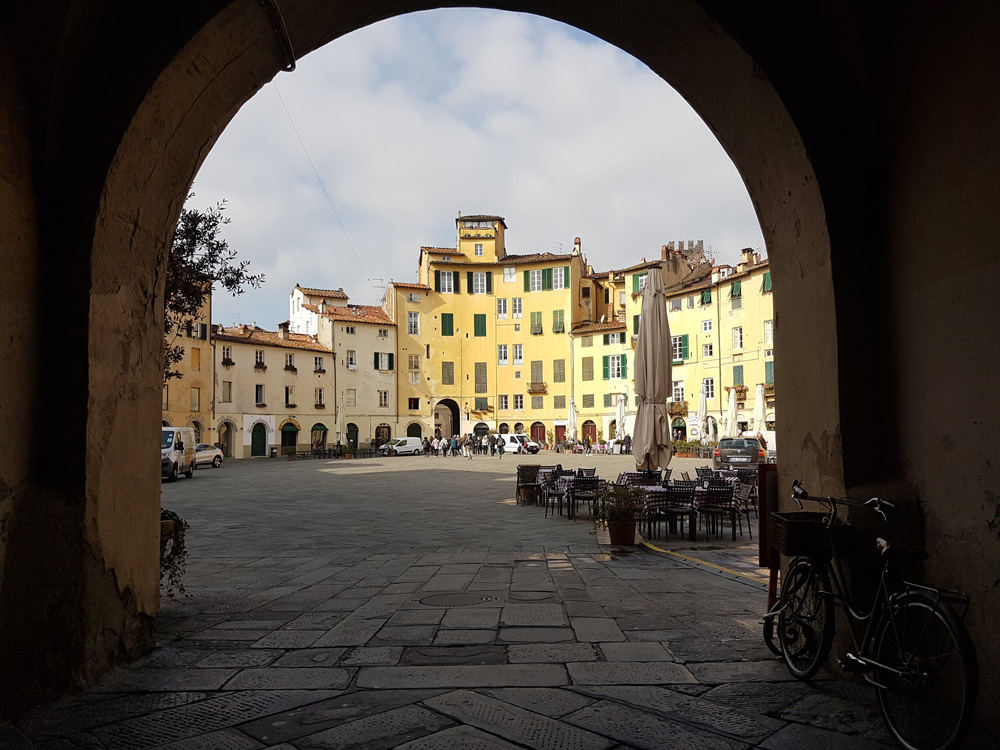Lucca tourist information
Lucca, in the central Italian region of Tuscany, is one of Italy’s less flashy destinations. Favoured by the quieter kind of foreign visitor, Lucca is often whispered of as a secret gem; an alternative to the high-season tourist madness of Florence, or Rome. A town still encircled by its wall, it is full of pastry shops and bicycles; visitors are more likely to be knocked down by an ambling bike than a car.
Luccas tradition has been one of sturdy independence rather than flamboyance, which means that the information boards you come across outside its more notable buildings are still usually in Italian only. In fact, the town boasts no famous showpieces, and therefore no crowds of tourists or rows of souvenir shops.
Lucca is roughly oval, flat and hardly a mile across. Within this span there are no wide roads to cross, but a multitude of old churches, little piazzas, towers and family businesses. Behind many an arching doorway there is a glimpse of vaulted passage or columned yard, usually private. This is a town where you can dispense with a map and simply walk or, like the locals, cycle: pretty soon youre bound to come back to somewhere you recognise or to the city rampart, which offers a high and grassy promenade (generally only resembling a wall when seen from outside).
Its possible, for a few euros, to climb one or other of the two highest bell-towers to look out on the mazy rooftops of the town and the surrounding Tuscan hills. A small circular piazza with entrances at the four points of the compass stands on the site of the towns Roman amphitheatre. The beautiful church of San Frediano, founded by an Irish saint, keeps the intact body of a later saint on show for the faithful, as well as a vast 12th-century font with figures carved with such force as to seem more Viking than Romanesque. For contrast, find the statue of Lucca’s favourite son, Puccini, relaxing with a cigarette
Lucca’s other tourist attractions include a fine Duomo in the Pisan style, alongside its own museum, both of which contain fine work by Jacopo della Quercia. Located over the old Roman forum, and named for it, is another grand church: San Michele in Foro. Art-lovers will want to explore the Pinacoteca Nazionale, the town’s art gallery and the Museo Guinigi, which contains sculpture as well as paintings.
Shoppers looking for smart boutiques should head for the Via Gallitassi; while more laid-back tourists will appreciate the coffee/tea shops and little places selling local wines and cheeses on Via Paulino. Both are on the western side of town but you will come upon them anyway as you explore the historic streets.
Concerts take place in the bigger piazzas during the summer, not necessarily Puccini and not all classical. There is an annual summer Puccini festival at nearby Torre del Lago. In Lucca itself there are concerts and recitals every day of the year at 7pm at the Church of San Giovanni. There are special discounts for Ryanair passengers.
There is a good tourist information office in a courtyard of the municipal palazzo fronting the Piazza Napoleone. Other places for information on Lucca and the district in general can be found around the town walls, including an office (with a useful toilet downstairs) by the bus station at the main western entrance.
Lucca travel information
The obvious approach is from Pisa, from which Lucca is only half-an-hour by car or by train, making the two cities a good double-bill. Trains shuttle between Lucca and Pisas main station about every hour, and the latter is also the station for Pisas airport. The distance between this airport and Pisa is exceptionally short around a mile the service between them operating about every twenty minutes for not much more than a euro. Buses run even more cheaply and frequently between airport and Pisa train station. Be warned, though, that this service tails off during the evening, and you should first check inside the terminal exactly where the bus stop is.
The main car parks are scattered around the main road which encircles the ramparts. The station is similarly placed, just south of the wall; on coming out you should aim half left to pass through the Porta San Pietro and then roughly straight on for a few more minutes to reach the big Piazza Napoleone.
Around Lucca
Theres a lot to be said for Lucca as a base. Its only a dozen miles from Pisa and fifty from Florence, while being less hectic than these honey-pots. Neither is the town so busy in summer as to go dead in winter. Going north from Lucca, the wooded hills soon turn into real mountains, often called the Apuan Alps or the Marble Mountains, which can be streaked with snow well into March. This area, the Garfagnana, is up-and-coming for those who like to combine their Tuscan villages with highly scenic walks: its main centre is little Barga, but with transport one could explore the district from Lucca itself.
Lucca accommodation
The choice of accommodation in Lucca ranges from chic city-centre B&Bs to grand villas in the nearby Tuscan countryside. Good options include the B&B Lucca Relais just outside the historic town walls, B&B Anfiteatro overlooking the Roman amphitheatre, and Hotel Ilaria & Residenza dell’Alba, a central hotel with a sun terrace and free bike hire.
> Lucca hotels, B&Bs and apartments
